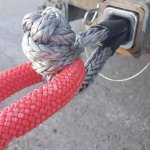Yeah. Their answer is weak sauce. Not satisfying. Left out important detail I am after.
I was looking at your site and your soft shackle reciever adapter idea looks good. Have you ever tested any of the 2" versions to the point of failure?
Pragmatically, the Bulldog shank only needs to be stronger than the rope I'm using. At 17T WLL, it has ridiculously higher WLL than any other 2" hitch shackle adapters I've seen. Even if you assume there is no margin of safety beyond the 17T WLL, and it immediatly fails at 34001lbs, it is still plenty for what I'm doing. I would never have any need to use it outside it's WLL. Though realistically, if I took an uneducated guess I'd bet that big blob of metal has a failure point well beyond its 17T WLL and so presumably a fair level of margin of safety before coming close to it's point of failure.
Not to say I'm sold on it or anything. Etrailer seems to have their name all over it and presmably something to lose if they give bad advice, maybe I'll ask what the breaking point is and see what they say.
And as you pointed out, at some level the pin becomes the limiting factor. I've only found 5/8" pins rated up to around 50-60k lbs or so. But there is also the question of the hitch and it's mounting but I will be sure and address all of that. If any of that stuff fails there will likely be some high energy projectiles.

